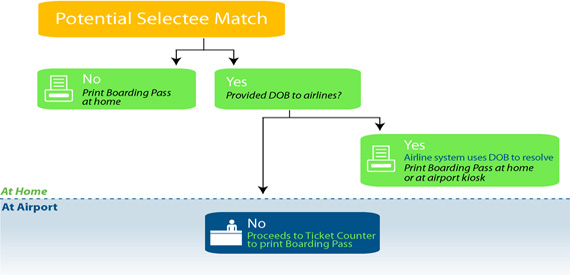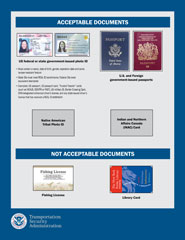Checkpoint Changes to Improve Security and Calm Process
April 28, 2008
Airlines May Now Allow Kiosk/At Home Check-in for Almost Everyone
One of the biggest complaints TSA receives comes from the thousands of people inconvenienced on a daily basis because they have a name similar to someone on a watch list. These passengers always have to go to the ticket counter and can never print their boarding pass from a home computer or airline kiosk. Until TSA's Secure Flight program comes into effect in early 2009, the airlines have the responsibility of matching names on flight manifests to watch lists. To eliminate the false positives and reduce the inconvenience to passengers, the Department of Homeland Security is now providing airlines with more flexibility to enable passengers to check in remotely.
Current Process

The Hassle Factor: Why Some People Can’t Print Their Boarding Pass

Proposed Solution
Effective April 28, every airline will be able to create a system to verify and securely store passengers' dates of birth to clear up watch list misidentifications. Once the airlines create their systems, passengers have the option to provide their date of birth first at the airline ticket counter, and then have it stored in a secure system so they can check-in online or at remote kiosks for future flights.

Driver's License or Passports Preferred ID at Checkpoints
Also on April 28, DHS and TSA provided greater clarity on the types of identification that will be accepted at checkpoints in the United States.
Beginning on May 26, 2008, adult passengers (18 and over) will be required to show a U.S. federal or state-issued photo ID that contains the following: name, date of birth, gender, expiration date and a tamper-resistant feature. These IDs include:
- U.S. passport
- U.S. passport card
- DHS "Trusted Traveler" cards (NEXUS, SENTRI, FAST)
- U.S. Military ID
- Permanent Resident Card
- Border Crossing Card
- DHS-designated enhanced driver's license
- Drivers Licenses or other state photo identity cards issued by Department of Motor Vehicles (or equivalent) that meets REAL ID benchmarks (All states are currently in compliance)
- A Native American Tribal Photo ID
- An airline or airport-issued ID (if issued under a TSA-approved security plan)
- A Registered Traveler Card (that contains the following: Name; Date of Birth; Gender; Expiration date; and a Tamper-resistant feature)
- A foreign government-issued passport
- Canadian provincial driver's license or Indian and Northern Affairs Canada (INAC) card
- Transportation Worker Identification Credential (TWIC)
Non-US/Canadian citizens are not required to carry their passports if they have documents issued by the U.S. government such as Permanent Resident Cards. Those who do not should be carrying their passports while visiting the U.S.
This standardization of the list of accepted documents better aligns TSA with other DHS components, including Customs and Border Protection, and REAL ID benchmarks.
Click here to view samples of acceptable documents (PDF, 148 KB).
Checkpoint Evolution Now Live at BWI
These innovations, along with the new Checkpoint Evolution prototype, are part of a broader effort to calm the checkpoint. The prototype at Baltimore-Washington Thurgood Marshall International Airport (BWI) includes multi-view X-ray, Millimeter Wave technology used in random continuous use, and liquid bottle scanners. These technologies, in conjunction with changes to the checkpoint environment and processes, will be evaluated for operational efficiency over the coming months.
Transportation Security Officers and managers at BWI are the first in the country to complete a 16-hour training module designed to incorporate the latest intelligence analysis, more advanced explosives detection skills, and ways to engage with passengers to promote a calmer environment for better security. The training was developed by TSA's Office of Intelligence, Bomb Appraisal Officers, and Checkpoint Evolution team.
Checkpoint Evolution is located in the Southwest Terminal, B Checkpoint at BWI. The layered security elements are both modular and flexible and designed to work individually, as well as part of an integrated package.



